Life Cycle Assessment of Hybrid Nanofiltration Desalination Plants in the Persian Gulf
Abstract
:1. Introduction
2. Methodology
2.1. Goals and Scopes
2.2. Systems and Functional Unit
2.3. Life Cycle Inventory Analysis
2.4. Life Cycle Impact Assessment (LCIA)
3. Results and Discussion
3.1. Life Cycle Impact Assessment (LCIA)
3.2. Sensitivity Analysis
4. Conclusions
Supplementary Materials
Author Contributions
Funding
Institutional Review Board Statement
Informed Consent Statement
Data Availability Statement
Acknowledgments
Conflicts of Interest
References
- Nations, U. World Population Prospects; United Nations Department of Economic and Social Affairs: New York, NY, USA, 2019. [Google Scholar]
- Water, U.W. UN World Water Development Report 2020; United Nation: New York, NY, USA, 2020. [Google Scholar]
- Akbar, A. The Best Desalination Technology for the Persian Gulf. Int. J. Soc. Ecol. Sustain. Dev. (IJSESD) 2011, 2, 55–65. [Google Scholar] [CrossRef] [Green Version]
- Younos, T.; Tulou, K.E. Overview of desalination techniques. J. Contemp. Water Res. Educ. 2005, 132, 3–10. [Google Scholar] [CrossRef] [Green Version]
- Bordbar, B.; Khosravi, A.; Azin, R. A Review on Sustainable Hybrid Water Treatment Processes. In Proceedings of the 3rd Biennial Oil, Gas, and Petrochemical Conference (OGPC2020), Bushehr, Iran, 28–30 December 2020; Available online: https://www.researchgate.net/publication/355162533_A_Review_on_Sustainable_Hybrid_Water_Treatment_Processes (accessed on 28 December 2020).
- Bonton, A.; Bouchard, C.; Barbeau, B.; Jedrzejak, S. Comparative life cycle assessment of water treatment plants. Desalination 2012, 284, 42–54. [Google Scholar] [CrossRef]
- Khosravi, A.; Bordbar, B.; Orkomi, A.A. Life Cycle Assessment of Emerging Technologies in Industrial Wastewater Treatment and Desalination. In Industrial Wastewater Treatment; Sptringer Nature: Berlin, Germany, 2022. [Google Scholar] [CrossRef]
- Mannan, M.; Alhaj, M.; Mabrouk, A.N.; Al-Ghamdi, S.G. Examining the life-cycle environmental impacts of desalination: A case study in the State of Qatar. Desalination 2019, 452, 238–246. [Google Scholar] [CrossRef]
- Kloepffer, W. Life cycle sustainability assessment of products. Int. J. Life Cycle Assess. 2008, 13, 89. [Google Scholar] [CrossRef]
- Hauschild, M.Z.; Rosenbaum, R.K.; Olsen, S.I. Life Cycle Assessment; Springer: Berlin, Germany, 2018; Volume 2018. [Google Scholar]
- Jolliet, O.; Saadé, M.; Crettaz, P. Analyse du Cycle de vie: Comprendre et Réaliser un Écobilan; PPUR Presses Polytechniques: Lausanne, Switzerland, 2010; Volume 23. [Google Scholar]
- Visentin, C.; da Silva Trentin, A.W.; Braun, A.B.; Thomé, A. Lifecycle assessment of environmental and economic impacts of nano-iron synthesis process for application in contaminated site remediation. J. Clean. Prod. 2019, 231, 307–319. [Google Scholar] [CrossRef]
- Fernandes, S.; da Silva, J.C.E.; da Silva, L.P. Comparative life cycle assessment of high-yield synthesis routes for carbon dots. NanoImpact 2021, 23, 100332. [Google Scholar] [CrossRef]
- Lundie, S.; Peters, G.M.; Beavis, P.C. Life cycle assessment for sustainable metropolitan water systems planning. Environ. Sci. Technol. 2004, 38, 3465–3473. [Google Scholar] [CrossRef] [Green Version]
- Raluy, R.G.; Serra, L.; Uche, J.; Valero, A. Life-cycle assessment of desalination technologies integrated with energy production systems. Desalination 2004, 167, 445–458. [Google Scholar] [CrossRef]
- Raluy, R.G.; Serra, L.; Uche, J. Life Cycle Assessment of Water Production Technologies—Part 1: Life Cycle Assessment of Different Commercial Desalination Technologies (MSF, MED, RO) (9 pp). Int. J. Life Cycle Assess. 2004, 10, 285–293. [Google Scholar] [CrossRef]
- Raluy, R.G.; Serra, L.; Uche, J.; Valero, A. Life Cycle Assessment of Water Production Technologies—Part 2: Reverse Osmosis Desalination versus the Ebro River Water Transfer (9 pp). Int. J. Life Cycle Assess. 2005, 10, 346–354. [Google Scholar] [CrossRef]
- Raluy, R.G.; Serra, L.; Uche, J. Life cycle assessment of desalination technologies integrated with renewable energies. Desalination 2005, 183, 81–93. [Google Scholar] [CrossRef]
- Raluy, G.; Serra, L.; Uche, J. Life cycle assessment of MSF, MED and RO desalination technologies. Energy 2006, 31, 2361–2372. [Google Scholar] [CrossRef]
- Stokes, J.; Horvath, A. Life Cycle Energy Assessment of Alternative Water Supply Systems (9 pp). Int. J. Life Cycle Assess. 2006, 11, 335–343. [Google Scholar] [CrossRef]
- Stokes, J.R.; Horvath, A. Energy and Air Emission Effects of Water Supply. Environ. Sci. Technol. 2009, 43, 2680–2687. [Google Scholar] [CrossRef] [Green Version]
- Vince, F.; Marechal, F.; Aoustin, E.; Bréant, P. Multi-objective optimization of RO desalination plants. Desalination 2008, 222, 96–118. [Google Scholar] [CrossRef]
- Vince, F.; Aoustin, E.; Bréant, P.; Marechal, F. LCA tool for the environmental evaluation of potable water production. Desalination 2008, 220, 37–56. [Google Scholar] [CrossRef]
- Muñoz, I.; Fernández-Alba, A.R. Reducing the environmental impacts of reverse osmosis desalination by using brackish groundwater resources. Water Res. 2008, 42, 801–811. [Google Scholar] [CrossRef]
- Muñoz, I.; Rodríguez, A.; Rosal, R.; Fernández-Alba, A.R. Life Cycle Assessment of urban wastewater reuse with ozonation as tertiary treatment: A focus on toxicity-related impacts. Sci. Total Environ. 2009, 407, 1245–1256. [Google Scholar] [CrossRef]
- Muñoz, I.; Milà-i-Canals, L.; Fernández-Alba, A.R. Life Cycle Assessment of Water Supply Plans in Mediterranean Spain. J. Ind. Ecol. 2010, 14, 902–918. [Google Scholar] [CrossRef]
- Beery, M.; Wozny, G.; Repke, J.-U. Sustainable Design of Different Seawater Reverse Osmosis Desalination Pretreatment Processes. In Computer Aided Chemical Engineering; Pierucci, S., Ferraris, G.B., Eds.; Elsevier: Amsterdam, The Netherlands, 2010; Volume 28, pp. 1069–1074. [Google Scholar]
- Beery, M.; Repke, J.-U. Sustainability analysis of different SWRO pre-treatment alternatives. Desalin. Water Treat. 2010, 16, 218–228. [Google Scholar] [CrossRef]
- Beery, M.; Hortop, A.; Wozny, G.; Knops, F.; Repke, J.-U. Carbon footprint of seawater reverse osmosis desalination pre-treatment: Initial results from a new computational tool. Desalin. Water Treat. 2011, 31, 164–171. [Google Scholar] [CrossRef]
- Meneses, M.; Pasqualino, J.C.; Céspedes-Sánchez, R.; Castells, F. Alternatives for Reducing the Environmental Impact of the Main Residue From a Desalination Plant. J. Ind. Ecol. 2010, 14, 512–527. [Google Scholar] [CrossRef]
- Zhou, J.; Chang, V.W.C.; Fane, A.G. Environmental life cycle assessment of brackish water reverse osmosis desalination for different electricity production models. Energy Environ. Sci. 2011, 4, 2267–2278. [Google Scholar] [CrossRef]
- Zhou, J.; Chang, V.W.C.; Fane, A.G. Environmental life cycle assessment of reverse osmosis desalination: The influence of different life cycle impact assessment methods on the characterization results. Desalination 2011, 283, 227–236. [Google Scholar] [CrossRef]
- Zhou, J.; Chang, V.W.C.; Fane, A.G. An improved life cycle impact assessment (LCIA) approach for assessing aquatic eco-toxic impact of brine disposal from seawater desalination plants. Desalination 2013, 308, 233–241. [Google Scholar] [CrossRef]
- Shahabi, M.P.; Anda, M.; Ho, G. Influence of site-specific parameters on environmental impacts of desalination. Desalin. Water Treat. 2015, 55, 2357–2363. [Google Scholar] [CrossRef]
- Aleisa, E.; Al-Shayji, K. Ecological–economic modeling to optimize a desalination policy: Case study of an arid rentier state. Desalination 2018, 430, 64–73. [Google Scholar] [CrossRef]
- Jijakli, K.; Arafat, H.; Kennedy, S.; Mande, P.; Theeyattuparampil, V.V. How green solar desalination really is? Environmental assessment using life-cycle analysis (LCA) approach. Desalination 2012, 287, 123–131. [Google Scholar] [CrossRef]
- Tarnacki, K.; Meneses, M.; Melin, T.; van Medevoort, J.; Jansen, A. Environmental assessment of desalination processes: Reverse osmosis and Memstill. Desalination 2012, 296, 69–80. [Google Scholar] [CrossRef]
- Ras, C.; Von Blottnitz, H. A comparative life cycle assessment of process water treatment technologies at the Secunda industrial complex, South Africa. Water SA 2012, 38, 549–554. [Google Scholar] [CrossRef] [Green Version]
- Godskesen, B.; Hauschild, M.; Rygaard, M.; Zambrano, K.; Albrechtsen, H.J. Life-cycle and freshwater withdrawal impact assessment of water supply technologies. Water Res. 2013, 47, 2363–2374. [Google Scholar] [CrossRef] [PubMed] [Green Version]
- Al-Shayji, K.; Aleisa, E. Characterizing the fossil fuel impacts in water desalination plants in Kuwait: A Life Cycle Assessment approach. Energy 2018, 158, 681–692. [Google Scholar] [CrossRef]
- Hancock, N.T.; Black, N.D.; Cath, T.Y. A comparative life cycle assessment of hybrid osmotic dilution desalination and established seawater desalination and wastewater reclamation processes. Water Res. 2012, 46, 1145–1154. [Google Scholar] [CrossRef]
- Al-Sarkal, T.; Arafat, H.A. Ultrafiltration versus sedimentation-based pretreatment in Fujairah-1 RO plant: Environmental impact study. Desalination 2013, 317, 55–66. [Google Scholar] [CrossRef]
- Linares, R.V.; Li, Z.; Yangali-Quintanilla, V.; Ghaffour, N.; Amy, G.; Leiknes, T.; Vrouwenvelder, J.S. Life cycle cost of a hybrid forward osmosis–low pressure reverse osmosis system for seawater desalination and wastewater recovery. Water Res. 2016, 88, 225–234. [Google Scholar] [CrossRef] [Green Version]
- Antipova, E.; Boer, D.; Cabeza, L.F.; Guillén-Gosálbez, G.; Jiménez, L. Uncovering relationships between environmental metrics in the multi-objective optimization of energy systems: A case study of a thermal solar Rankine reverse osmosis desalination plant. Energy 2013, 51, 50–60. [Google Scholar] [CrossRef] [Green Version]
- Cherif, H.; Champenois, G.; Belhadj, J. Environmental life cycle analysis of a water pumping and desalination process powered by intermittent renewable energy sources. Renew. Sustain. Energy Rev. 2016, 59, 1504–1513. [Google Scholar] [CrossRef]
- Karami, S.; Karami, E.; Zand-Parsa, S. Environmental and economic appraisal of agricultural water desalination use in South Iran: A comparative study of tomato production. J. Appl. Water Eng. Res. 2017, 5, 91–102. [Google Scholar] [CrossRef]
- Shahabi, M.P.; McHugh, A.; Anda, M.; Ho, G. Comparative economic and environmental assessments of centralised and decentralised seawater desalination options. Desalination 2015, 376, 25–34. [Google Scholar] [CrossRef]
- Shahabi, M.P.; McHugh, A.; Ho, G. Environmental and economic assessment of beach well intake versus open intake for seawater reverse osmosis desalination. Desalination 2015, 357, 259–266. [Google Scholar] [CrossRef]
- Norwood, Z.; Kammen, D. Life cycle analysis of distributed concentrating solar combined heat and power: Economics, global warming potential and water. Environ. Res. Lett. 2012, 7, 044016. [Google Scholar] [CrossRef] [Green Version]
- Ronquim, F.M.; Sakamoto, H.M.; Mierzwa, J.; Kulay, L.; Seckler, M.M. Eco-efficiency analysis of desalination by precipitation integrated with reverse osmosis for zero liquid discharge in oil refineries. J. Clean. Prod. 2020, 250, 119547. [Google Scholar] [CrossRef]
- Tsalidis, G.A.; Gallart, J.J.E.; Corberá, J.B.; Blanco, F.C.; Harris, S.; Korevaar, G. Social life cycle assessment of brine treatment and recovery technology: A social hotspot and site-specific evaluation. Sustain. Prod. Consum. 2020, 22, 77–87. [Google Scholar] [CrossRef]
- Biswas, W.K. Life cycle assessment of seawater desalinization in Western Australia. World Acad. Sci. Eng. Technol. 2009, 56, 369–375. [Google Scholar]
- Goga, T.; Friedrich, E.; Buckley, C. Environmental life cycle assessment for potable water production—A case study of seawater desalination and mine-water reclamation in South Africa. Water SA 2019, 45, 700–709. [Google Scholar] [CrossRef] [Green Version]
- Mabrouk, A.; Koc, M.; Abdala, A. Technoeconomic analysis of tri hybrid reverse osmosis-forward osmosis-multi stage flash desalination process. Desalin. Water Treat. 2017, 98, 1–15. [Google Scholar] [CrossRef]
- Mabrouk, A.N.A.; Fath, H.E.-b.S. Techno-economic analysis of hybrid high performance MSF desalination plant with NF membrane. Desalin. Water Treat. 2013, 51, 844–856. [Google Scholar] [CrossRef]
- Avlonitis, S.; Kouroumbas, K.; Vlachakis, N. Energy consumption and membrane replacement cost for seawater RO desalination plants. Desalination 2003, 157, 151–158. [Google Scholar] [CrossRef]
- Huijbregts, M.; Steinmann, Z.; Elshout, P.; Stam, G.; Verones, F.; Vieira, M.; Hollander, A.; Zijp, M.; van Zelm, R. ReCiPe 2016 v1. 1 A Harmonized Life Cycle Impact Assessment Method at Midpoint and Endpoint Level Report I: Characterization; National Institute for Public Health and the Environment: Bilthoven, The Netherlands, 2017. [Google Scholar]
- Darwish, M.A.; Abdulrahim, H.K.; Hassan, A.S. Realistic power and desalted water production costs in Qatar. Desalin. Water Treat. 2016, 57, 4296–4302. [Google Scholar] [CrossRef]
- Elazhar, F.; Elazhar, M.; El Filali, N.; Belhamidi, S.; Elmidaoui, A.; Taky, M. Potential of hybrid NF-RO system to enhance chloride removal and reduce membrane fouling during surface water desalination. Sep. Purif. Technol. 2021, 261, 118299. [Google Scholar] [CrossRef]
- Ghahremani, R.; Baheri, B.; Peydayesh, M.; Asarehpour, S.; Mohammadi, T. Novel crosslinked and zeolite-filled polyvinyl alcohol membrane adsorbents for dye removal. Res. Chem. Intermed. 2015, 41, 9845–9862. [Google Scholar] [CrossRef]
- Gorris, L.G.M.; Yoe, C.E. Risk Analysis: Risk Assessment: Principles, Methods, and Applications. Encycl. Food Saf. 2014. [Google Scholar] [CrossRef]
- Pichery, C. Sensitivity Analysis. In Encyclopedia of Toxicology, 3rd ed.; Philip, W., Ed.; Academic Press: Oxford, UK, 2014; pp. 236–237. [Google Scholar] [CrossRef]
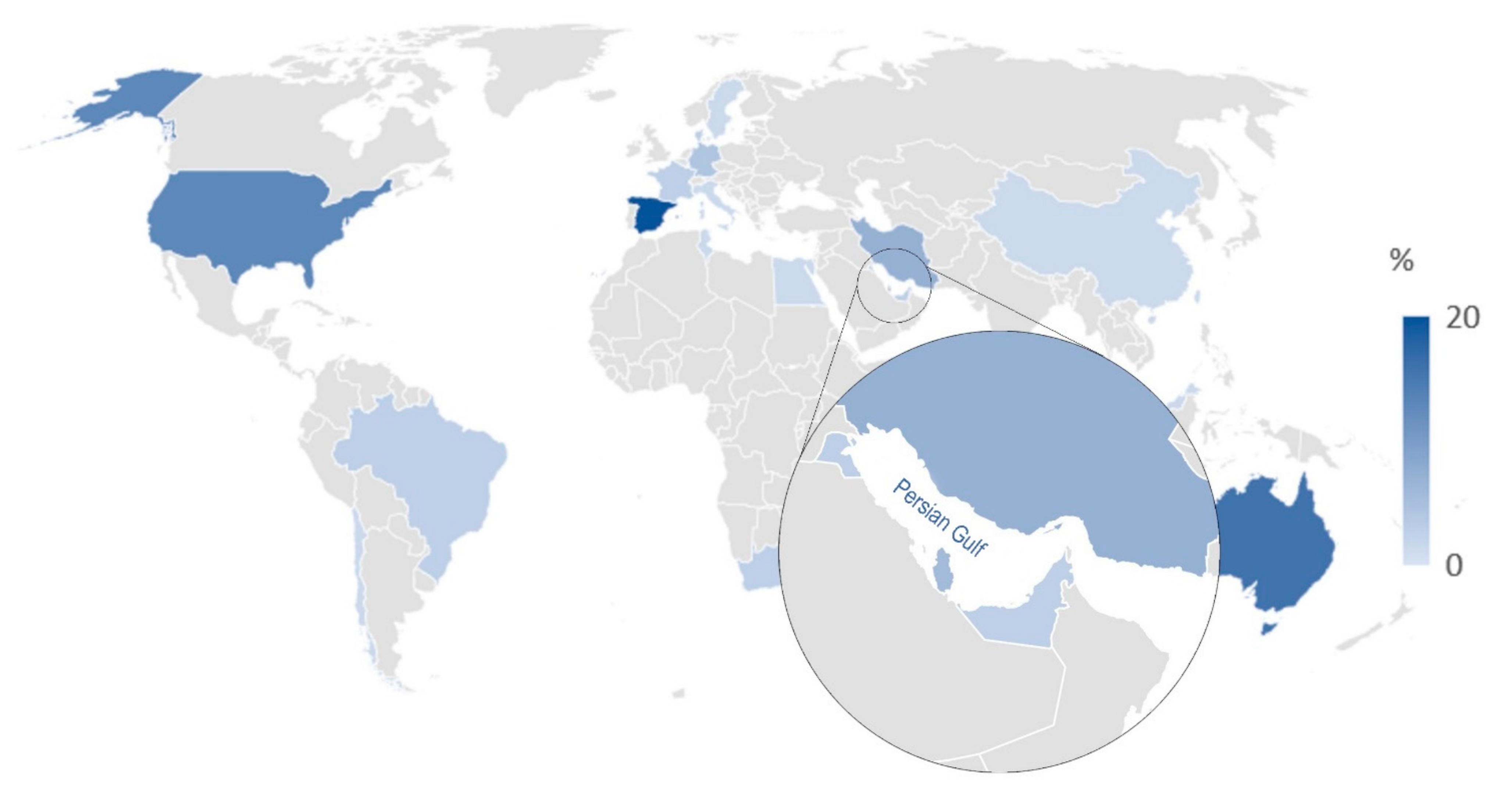
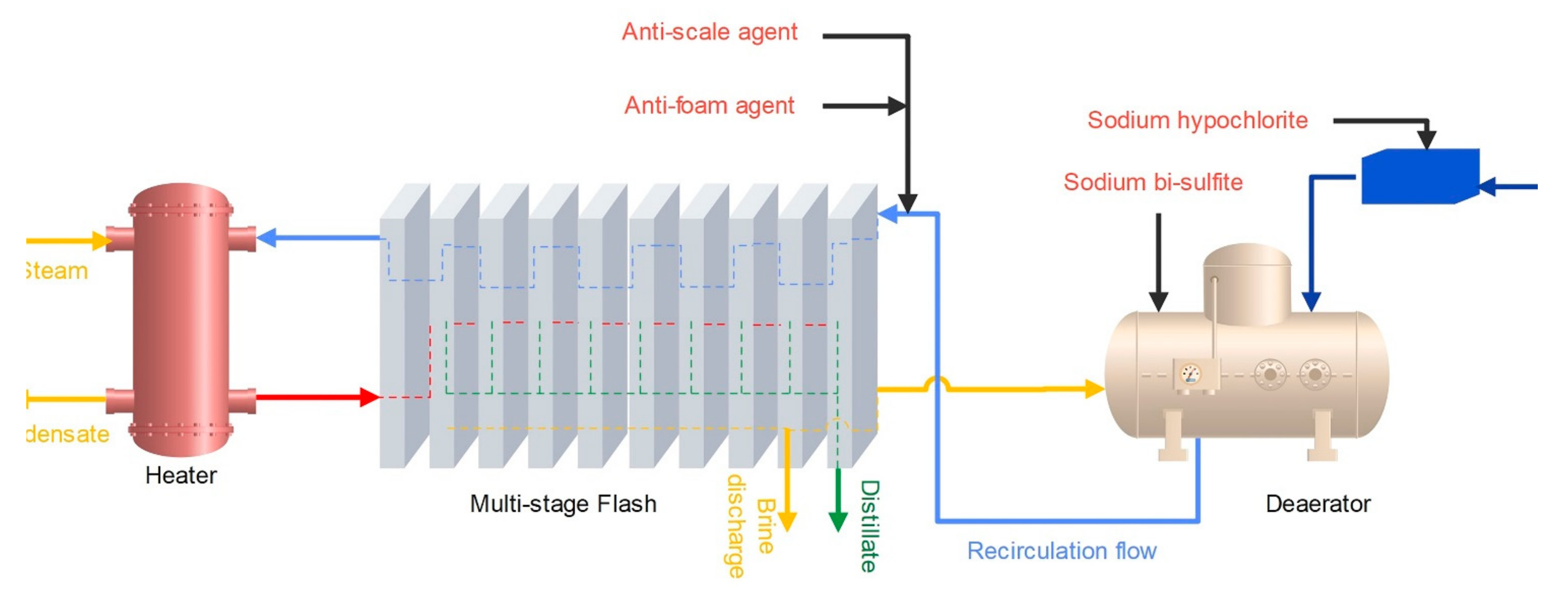
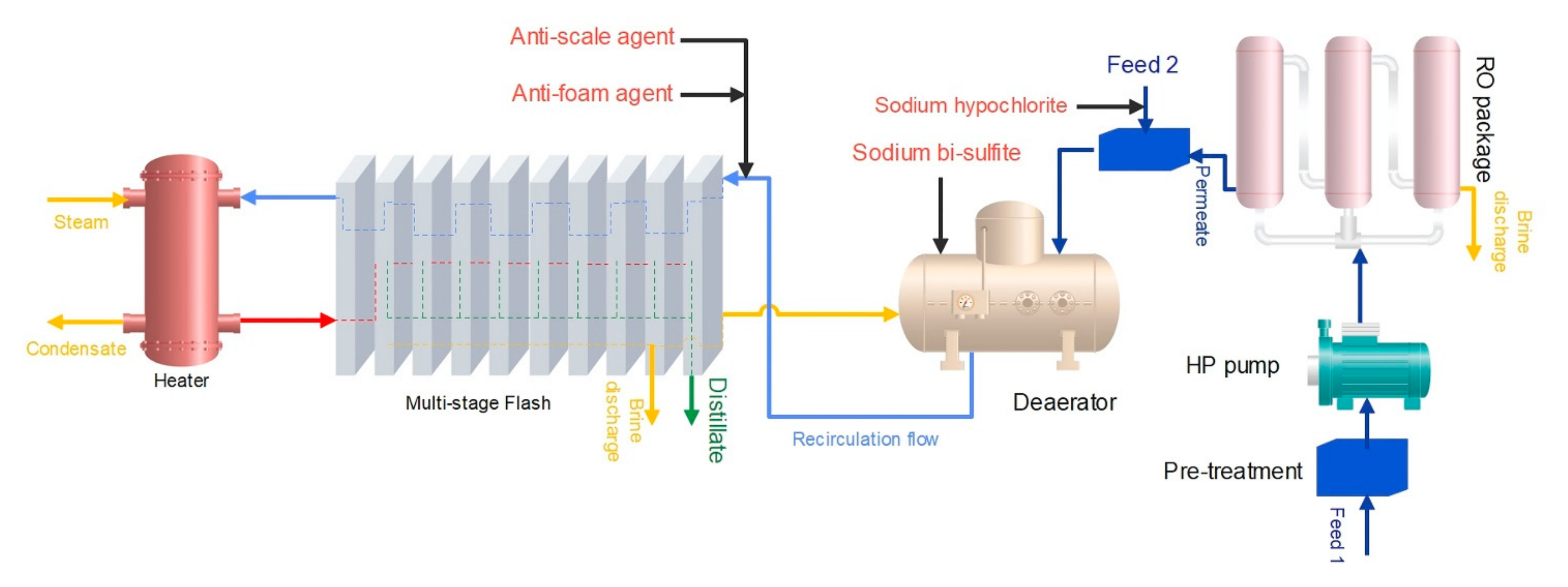



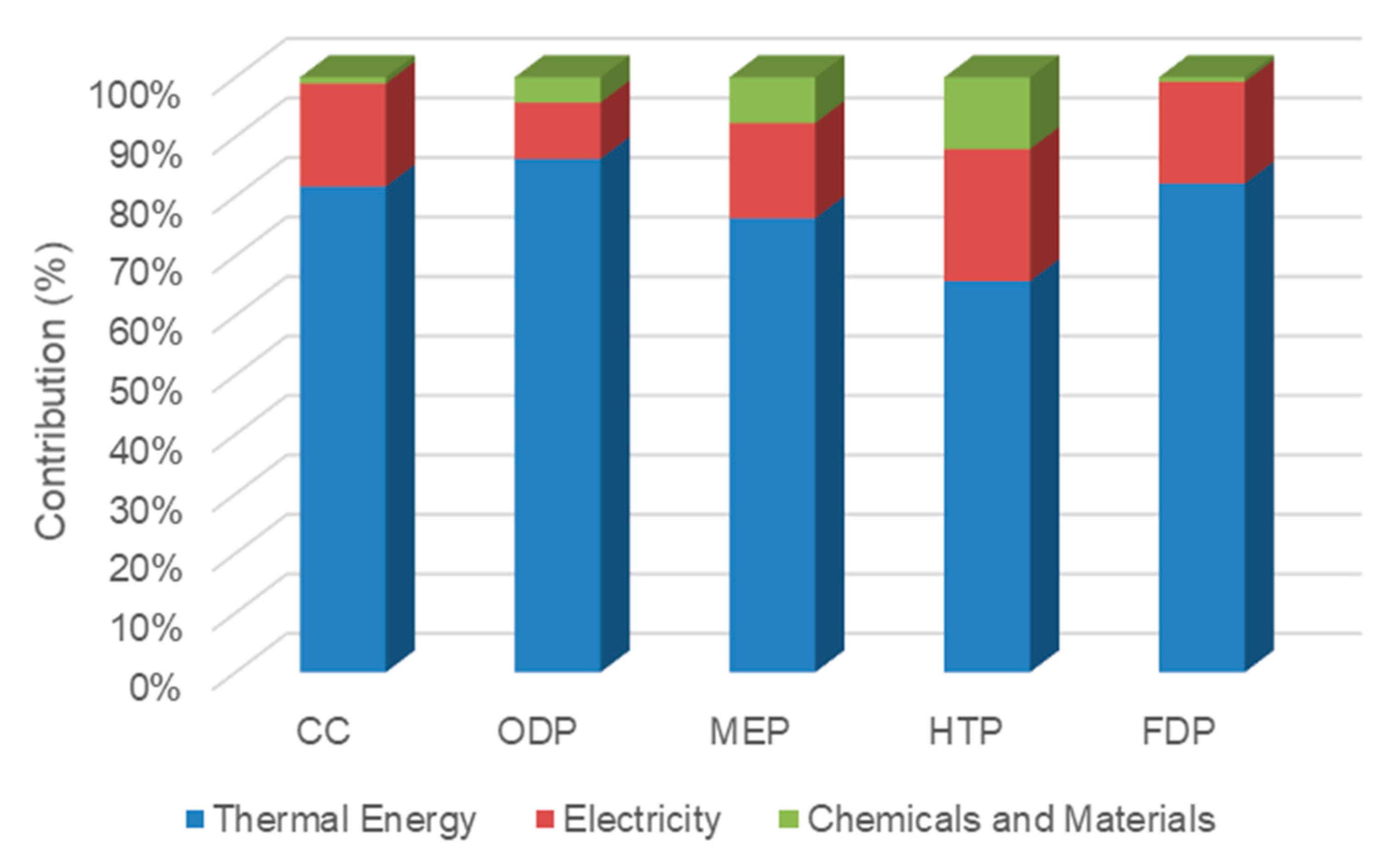
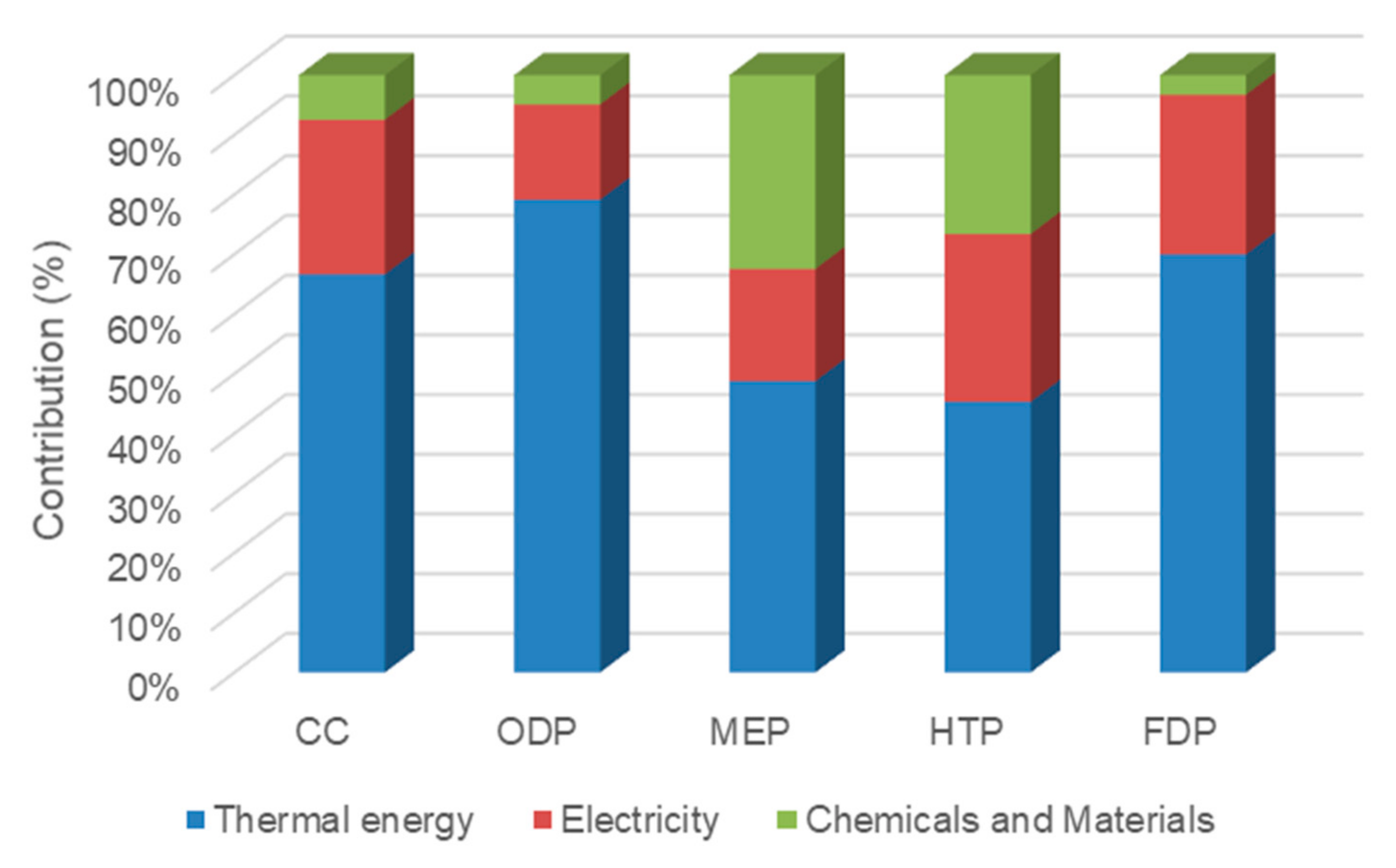
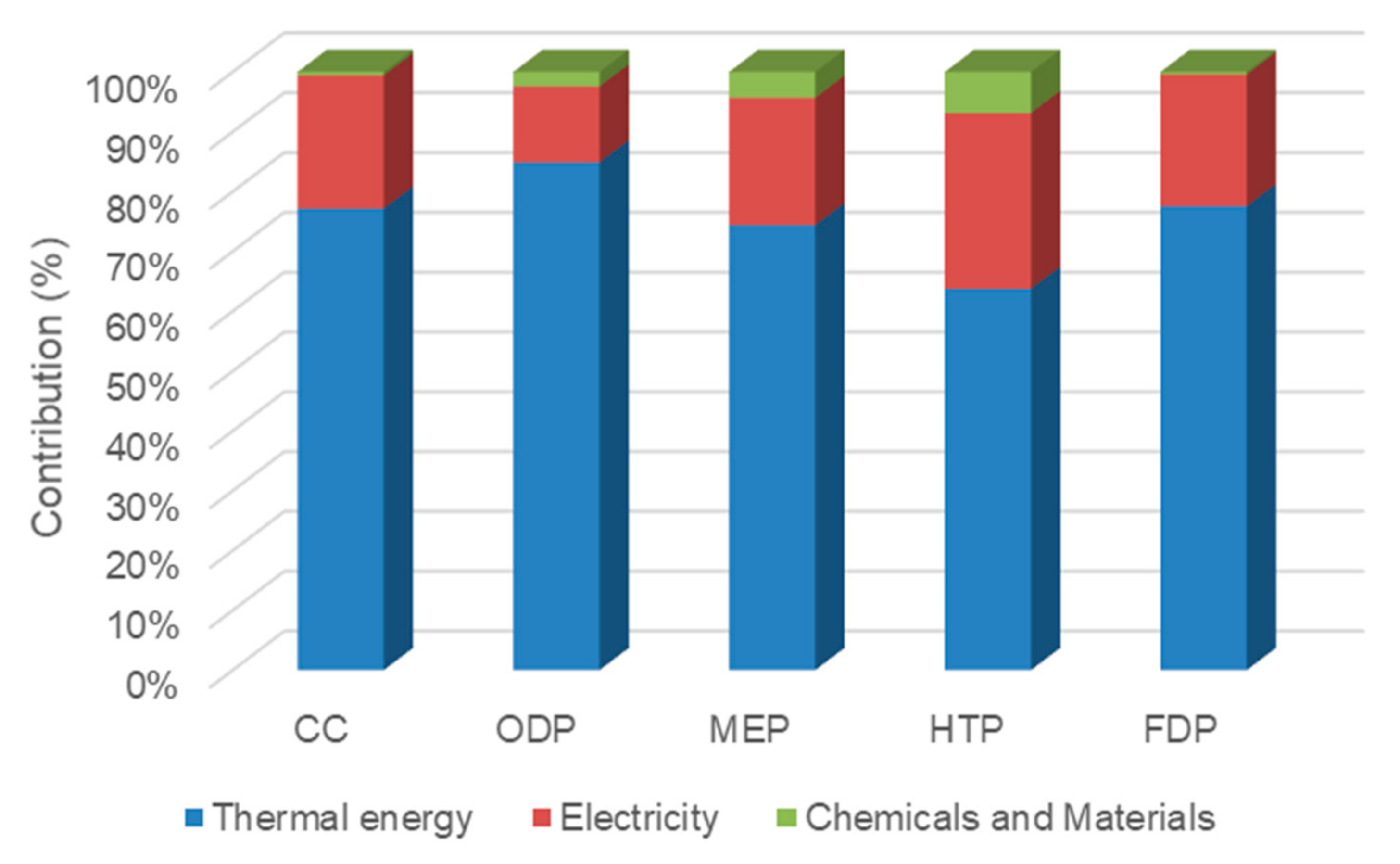
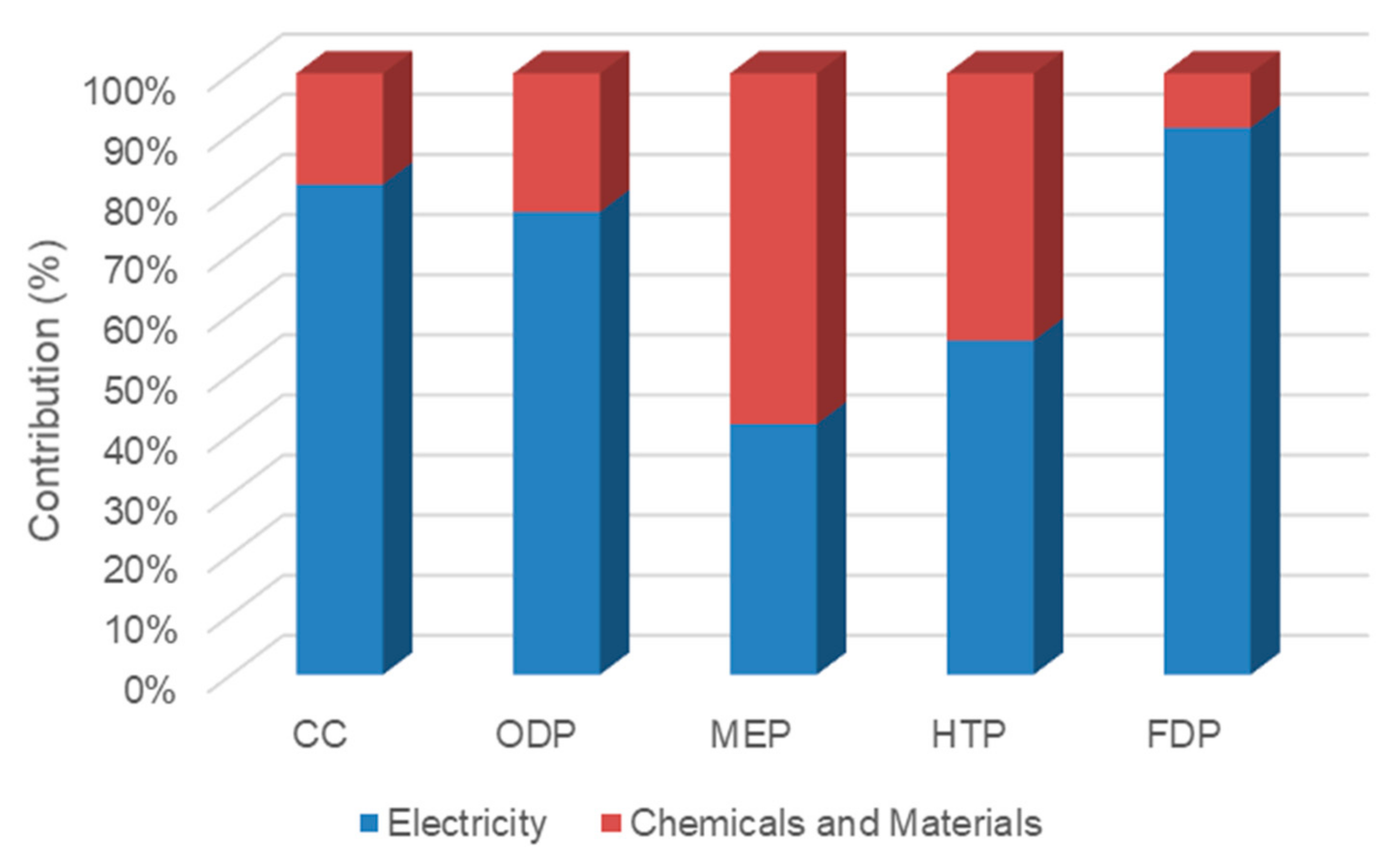
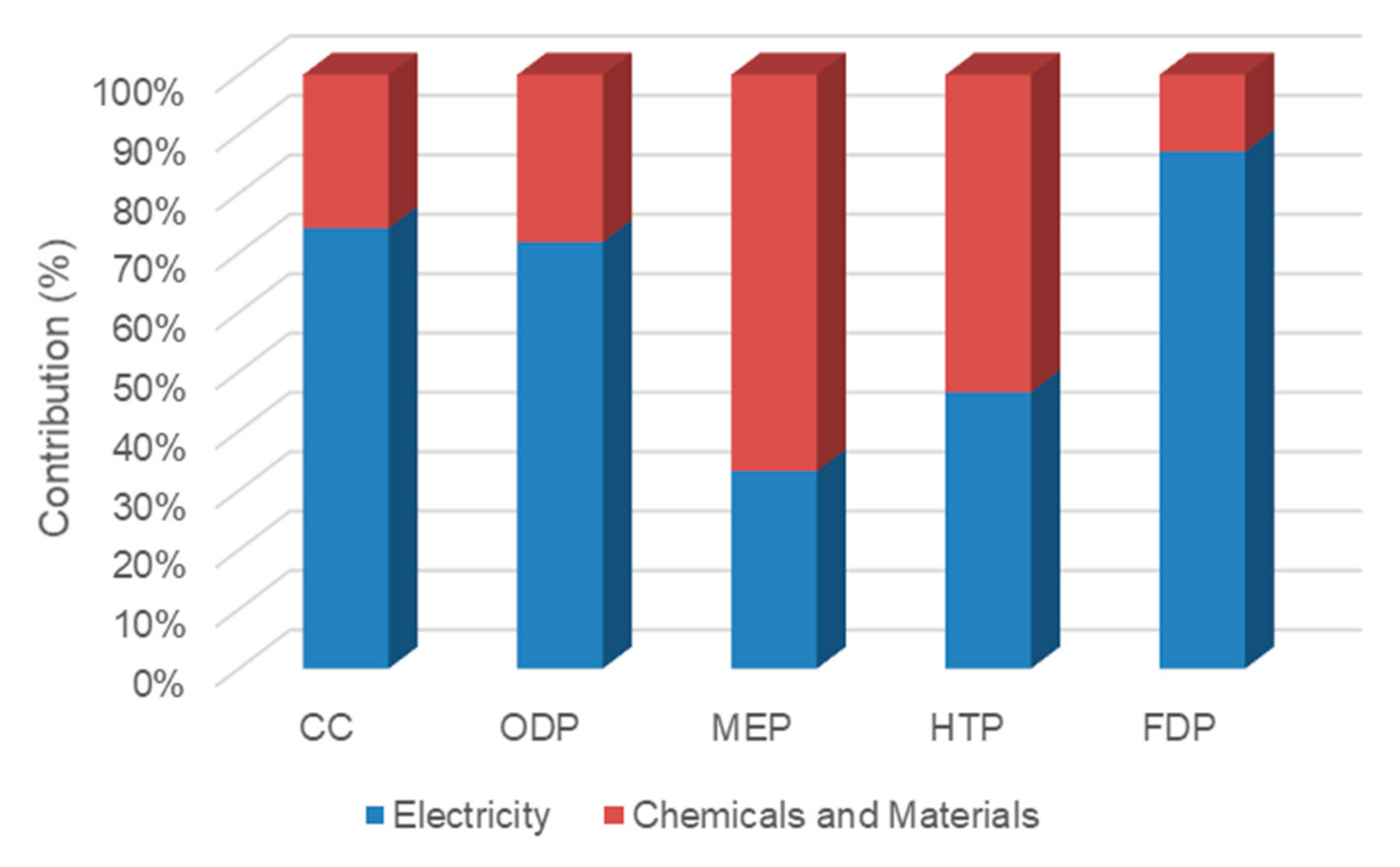
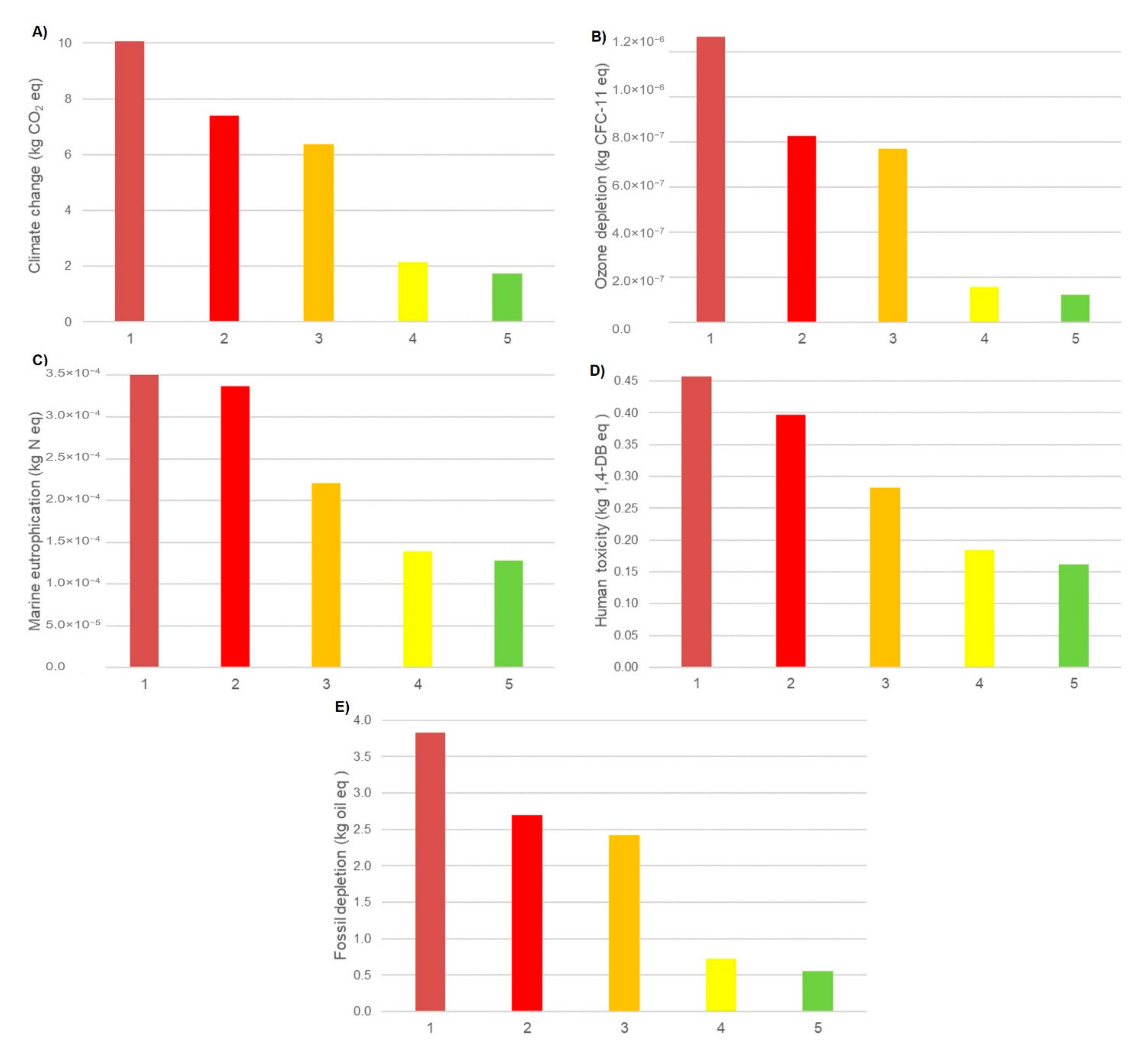
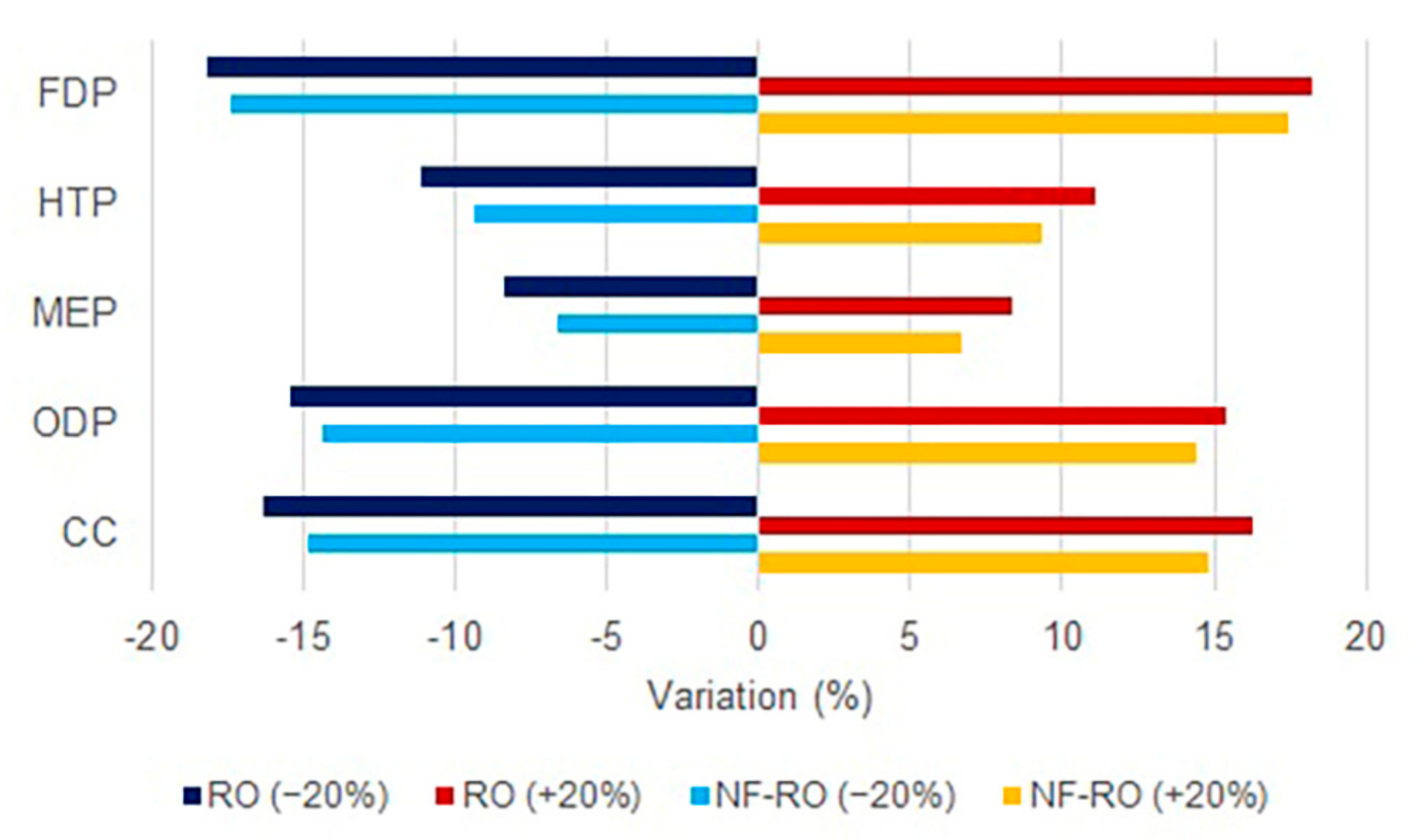
| Plant Specification | Case 1 | Case 2 | Case 3 | Case 4 | Case 5 |
|---|---|---|---|---|---|
| Technology | R-MSF | Hybrid RO/R-MSF | Hybrid NF/R-MSF | RO | Hybrid NF/RO |
| Configuration | Cross tube MSF | Cross tube MSF Single-pass RO | Cross tube MSF Single-pass NF | Single-pass RO | Single-pass NF Single-pass RO |
| Number of stages | 21 | 35 | 35 | - | - |
| Thermal energy (MJ) | 107 | 64 | 64 | - | - |
| Electrical energy (kWh/m3) | 4.19 | 4.6 | 3.42 | 4.22 | 3.11 |
| Feed (seawater) Flowrate (m3/h) | 28,000 | 675 | 675 | 675 | 675 |
| Treated water flowrate (m3/h) | 3430.57 | 378 | 288.1 | 405 | 303.75 |
| Reference | [8] | [52,56] | [8] | [52,56] | [52,55,56] |
| Stage | Chemicals | Amount (ppm) |
|---|---|---|
| Pre-treatment cases 1–5 | Sodium hypochlorite | 4 |
| Sodium bisulfite | 0.5 | |
| Sulfuric acid | 2.4 | |
| Monoethyleneoxide | 0.1 | |
| Post-treatment for cases 1–5 | Calcium hydroxide | 0.5 |
| Sodium hypochlorite | 0.5 | |
| Pre-treatment for NF and RO system | Ferric chloride | 0.3 |
| Post-treatment for NF and RO system | Chlorine | 0.2 |
| Pre-treatment for RO system | Citric acid | 0.937 |
| Sodium sulfite | 0.0739 | |
| Post-treatment for RO system | Lime | 51.03 |
| Carbon dioxide | 43 |
| Component | Amount (kg/m3) |
|---|---|
| Polyester | 4.79452 × 10−11 |
| Polysulfone | 1.0274 × 10−11 |
| DMF (N,N-dimethylformamide) | 4.10959 × 10−11 |
| MPD (meta-phenylene diamine) | 4.62329 × 10−13 |
| TMC (trimesoyl chloride) | 1.19178 × 10−12 |
| Phosphoric acid | 3.20548 × 10−12 |
| Polypropylene (spacers) | 5.13699 × 10−11 |
| Epoxy resin (glue) | 1.16438 × 10−11 |
| PVC (permeate tube) | 1.78082 × 10−11 |
| IPA (isopropanol) | 5.82192 × 10−12 |
| Component | Amount (kg/m3) |
|---|---|
| ABS (Acrylonitrile-butadiene-styrene copolymer) | 2.90964 × 10−13 |
| Polyester | 2.0077 × 10−13 |
| Polysulfone | 2.12833 × 10−13 |
| DMF (N,N-dimethylformamide) | 8.52231 × 10−12 |
| MPD (meta-phenylene diamine) | 9.00922 × 10−16 |
| TMC (trimesoyl chloride) | 2.69506 × 10−15 |
| Phosphoric acid | 6.31159 × 10−14 |
| Polypropylene (spacers) | 4.26565 × 10−13 |
| Epoxy resin (glue) | 1.17299 × 10−14 |
| PVC (permeate tube) | 1.3347 × 10−15 |
| IPA (isopropanol) | 2.10215 × 10−14 |
| Impact | Unit | Case 1 | Case 2 | Case 3 | Case 4 | Case 5 |
|---|---|---|---|---|---|---|
| Climate change | kg CO2 eq | 10.08 | 7.39 | 6.38 | 2.15 | 1.74 |
| Ozone depletion | kg CFC-11 eq | 1.27 × 10−6 | 8.26 × 10−7 | 7.70 × 10−7 | 1.57 × 10−7 | 1.24 × 10−7 |
| Marine eutrophication | kg N eq | 3.60 × 10−4 | 3.37 × 10−4 | 2.21 × 10−4 | 1.39 × 10−4 | 1.28 × 10−4 |
| Human toxicity | kg 1,4-DB eq | 0.46 | 0.40 | 0.28 | 0.18 | 0.16 |
| Fossil depletion | kg oil eq | 3.83 | 2.69 | 2.43 | 0.72 | 0.56 |
Publisher’s Note: MDPI stays neutral with regard to jurisdictional claims in published maps and institutional affiliations. |
© 2022 by the authors. Licensee MDPI, Basel, Switzerland. This article is an open access article distributed under the terms and conditions of the Creative Commons Attribution (CC BY) license (https://creativecommons.org/licenses/by/4.0/).
Share and Cite
Bordbar, B.; Khosravi, A.; Ahmadi Orkomi, A.; Peydayesh, M. Life Cycle Assessment of Hybrid Nanofiltration Desalination Plants in the Persian Gulf. Membranes 2022, 12, 467. https://doi.org/10.3390/membranes12050467
Bordbar B, Khosravi A, Ahmadi Orkomi A, Peydayesh M. Life Cycle Assessment of Hybrid Nanofiltration Desalination Plants in the Persian Gulf. Membranes. 2022; 12(5):467. https://doi.org/10.3390/membranes12050467
Chicago/Turabian StyleBordbar, Benyamin, Arash Khosravi, Ali Ahmadi Orkomi, and Mohammad Peydayesh. 2022. "Life Cycle Assessment of Hybrid Nanofiltration Desalination Plants in the Persian Gulf" Membranes 12, no. 5: 467. https://doi.org/10.3390/membranes12050467







